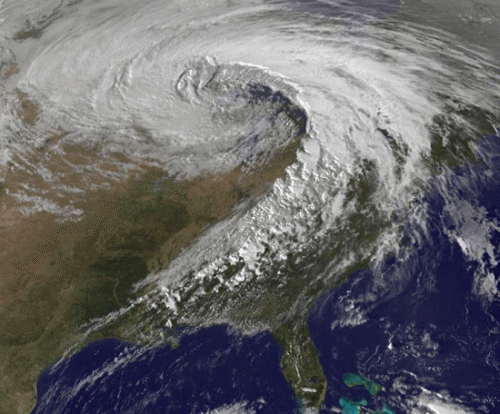
Yesterday a giant storm ripped through the Midwest, described as a land hurricane, a weather bomb, a chiclone (Chicago cyclone), what it was was very unusual and very strong. In a year of crazy floods, record high heat, this is yet another reminder of what we have in store if we don’t address climate change now.
Yesterday’s records in context
Yesterday’s 28.20″ (955 mb) low pressure reading in Minnesota breaks not only the 28.28″ (958 mb) previous “USA-interior-of-the-continent-record” from Cleveland, Ohio during the Great Ohio Storm of Jan. 26, 1978 (a lower reading in Canada during this event bottomed out at an amazing 28.05″/950 mb), but also the lowest pressure ever measured anywhere in the continental United States aside from the Atlantic Coast. The modern Pacific Coast record is 28.40″ (962mb) at Quillayute, Washington on Dec. 1, 1987. An older reading, taken on a ship offshore from the mouth of the Umpqua River in Oregon during the famous “Storm King” event on January 9, 1880, is tied with yesterday’s 28.20″ (955 mb.)The lowest non-hurricane barometric pressure reading in the lower 48 states is 28.10″ (952 mb) measured at Bridgehampton, New York (Long Island) during an amazing nor’easter on March 1, 1914 (see Kocin and Uccellini, “Northeast Snowstorms; Vol. 2., p. 324, American Meteorological Society, 2004.) The lowest non-hurricane barometric pressure reading from anywhere in the United States was a 27.35″ (927 mb) reading at Dutch Harbor, Alaska on Oct. 25, 1977. The lowest hurricane pressure reading was the 26.34″ (892 mb) recorded in 1935 during the Great Labor Day Hurricane.
The six most intense storms in history to affect the Great Lakes
According to the Chicago branch of the National Weather Service and Christopher C. Burt, our Weather Records blogger, the following are the six lowest pressures measured in the U.S. Great Lakes region:1. Yesterday’s October 26, 2010 Superstorm (955 mb/28.20″)
2. Great Ohio Blizzard January 26, 1978 (958 mb/28.28″)
3. Armistice Day Storm November 11, 1940 (967 mb/28.55″)
4. November 10, 1998 storm (967 mb/ 28.55″)
5. White Hurricane of November 7 – 9, 1913 (968 mb/28.60″)
6. Edmund Fitzgerald Storm of November 10, 1975 (980 mb/28.95″)So, the famed storm that sank the ore carrier Edmund Fitzgerald in 1974, killing all 29 sailors aboard, was weaker than the current storm. Indeed, I wouldn’t want to be on a boat in Lake Superior today–sustained winds at the Rock of Ages lighthouse on Isle Royale were a sustained 68 mph, gusting to 78 mph at 3am EDT this morning!
Yet Another Remarkable Mid-latitude Cyclone so far this Year!
Yesterday’s superstorm is reminiscent of the amazing low pressures reached earlier this year (Jan. 19-22) in the West, where virtually every site in California, Nevada, Utah, Arizona, southern Oregon, and southern Idaho–about 10 – 15% of the U.S. land area–broke their lowest on record pressure readings. However, the lowest readings from that event fell well short of yesterday’s mega-storm with 28.85” (977 mb) being about the lowest recorded at any onshore site.
From Wonk Room
an unprecedented, freak “land hurricane” swept through the continental United States, leaving a path of devastation from Saskatchewan to Texas — while the Republican Party has been taken over by a hurricane of science denial. Our destabilized climate system, supercharged with billions of tons of manmade global warming pollution, is unlike anything in the historical record. “Welcome to the Land of 10,000 Weather Extremes,” Minnesota meteorologist Paul Douglas gasped. “The storm is huge,” Peter Kimbell, emergency preparedness meteorologist for Environment Canada, said. “Much of North America is being affected by this storm. It’s covering millions of square kilometers.” Even the right-wing Anthony Watts called this storm — centered in Wisconsin — a “subtropical/tropically oriented monster.” Douglas found intensity of the “weather bomb” something “hard to fathom”:
Yesterday a rapidly intensifying storm, a “bomb”, spun up directly over the MN Arrowhead, around mid afternoon a central pressure of 953 millibars was observed near Orr. That’s 28.14? of mercury. Bigfork, MN reported 955 mb, about 28.22? of mercury. The final (official) number may be closer to 28.20-28.22?, but at some point the number becomes academic. What is pretty much certain is that Tuesday’s incredible storm marks a new record for the lowest atmospheric pressure ever observed over the continental USA. That’s a lower air pressure than most hurricanes, which is hard to fathom.
beautiful Indonesia